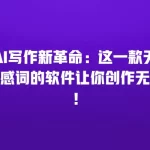共计 3063 个字符,预计需要花费 8 分钟才能阅读完成。
In recent years, artificial intelligence (AI) has revolutionized various industries, and academic writing is no exception. With the rise of AI-powered tools like ChatGPT, students and professionals are increasingly turning to these technologies to assist in writing papers. But the question arises: Are AI-written papers reliable? In this article, we will explore the advantages and disadvantages of using AI academic writing tools.
AI academic writing tools leverage machine learning algorithms to assist users in generating text, conducting research, and even suggesting structures for their papers. These tools can generate content quickly, making them tempting options for busy students facing deadlines. However, understanding the limitations and best practices for using these tools is crucial.
Speed and Efficiency
One of the most significant benefits of AI writing tools is their ability to produce content rapidly. For students overwhelmed with coursework, AI can help draft sections of a paper, allowing them to focus on research and analysis.
Reduced Writer’s Block
Writers often experience creative blocks that hinder their productivity. AI tools can offer suggestions, prompts, or even complete paragraphs, helping users overcome these obstacles and maintain momentum.
Improved Grammar and Style

参考文章: 游戏鼠标推荐:选择适合你的电竞装备,提升游戏体验的秘密武器!
Many AI writing tools come equipped with grammar-checking features that can enhance the quality of writing. They can suggest stylistic improvements and corrections, which can be particularly useful for non-native English speakers.
Lack of Originality
Although AI can generate text quickly, it often relies on existing content, leading to concerns about originality. Papers generated by AI may inadvertently plagiarize or closely mimic existing materials, which poses a risk for academic integrity.
Misunderstanding of Context
AI tools may not fully grasp the nuances of complex topics or specific academic requirements. This can result in inaccurate information or inappropriate responses, undermining the reliability of the content produced.
Dependency Issues
Over-reliance on AI tools for writing can hinder a student’s development of essential writing and critical thinking skills. Writing is not just about putting words on paper; it’s about articulating arguments and engaging with material, which could be compromised.
To harness the benefits of AI while mitigating its risks, users should follow these best practices:
Use as a Supplement, Not a Substitute: AI tools should assist in the writing process but not replace personal engagement with the material.
Conduct Thorough Research: Users should verify the information generated by AI tools and ensure it aligns with credible sources or original research.
Edit and Refine: AI-generated text often requires significant editing to fit the desired tone and context. Users should take the time to review and modify the content to make it their own.
AI academic writing tools offer significant advantages in speed and efficiency, but they come with caveats. While they can alleviate some of the burdens of academic writing, users must approach them responsibly. By understanding both the pros and cons, and following best practices, students and professionals can make the most of these technological advancements while maintaining the integrity of their academic work. Ultimately, AI-written papers may be reliable when used as a tool for enhancement rather than as a crutch.








